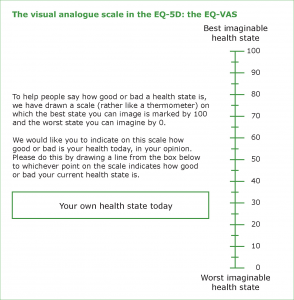Sign up to our newsletter Subscribe
Analysing Global Immunisation Expenditure

Sign up to our newsletter Subscribe


This research addresses two critical issues about the use of the EQ-VAS. A paper recently published in Quality of Life Research by OHE’s Nancy Devlin and Yan Feng with David Parkin, King’s College, London, describes research on the use of…

This research addresses two critical issues about the use of the EQ-VAS.
A paper recently published in Quality of Life Research by OHE’s Nancy Devlin and Yan Feng with David Parkin, King’s College, London, describes research on the use of the EQ-VAS in the NHS Patient Reported Outcome Measures (PROMs) programme.
A paper recently published in Quality of Life Research by OHE’s Nancy Devlin and Yan Feng with David Parkin, King’s College, London, describes research on the use of the EQ-VAS in the NHS Patient Reported Outcome Measures (PROMs) programme[1]. Introduced in April 2009, PROMs data now are used in a range of decision making contexts.
The EQ-5D, used to collect the PROMs data, has two parts. The first, the EQ-5D profile, asks patients to classify their health based on self-assessed levels of problems (“no”, “some”, “extreme”). The second is the EQ-VAS, which asks patients to indicate their overall health on a vertical visual analogue scale, ranging from “worst possible” to “best possible” health. Historically, the EQ-VAS was a warm-up exercise for VAS valuations of EQ-5D, but it has evolved into an integral part of the measure.
This paper focuses on two concerns about the EQ-VAS: (1) difficulties with the data because patients may fail to respond to it as the instructions require and (2) substantial differences between patient responses on the EQ-VAS versus the EQ-5D profile and condition-specific instruments. According to the authors, these issues raise fundamental questions about the role and use of EQ-VAS in the EQ-5D instrument.
In particular, the paper analyses:
The authors’ findings suggest ways for improving EQ-VAS by improving both data collection and coding procedures. They note, for example, that although 95% of patients completed the EQ-VAS in an unambiguous way, fewer than 50% completed it in the way that the instructions intend. Moreover, the guidance provided by the EuroQol Group on coding the imperfect responses is insufficient in ways that may negatively affect data use. “All of these issues,” they note, “could be addressed by providing improved guidance on coding EQ-VAS data or revisiting the instructions for the EQ-VAS”.
The third set of analyses address whether and how patient-reported outcomes vary using EQ-VAS versus EQ-5D or condition-specific instruments. The authors note that “Concern had emerged from the NHS PROMs programme that the EQ-VAS was not adequately reflecting the health gain for patients resulting from surgery, and was therefore a less useful and appropriate measure of health change than the EQ-5D profile or condition specific instruments.” Their findings suggest that this is not the case; the relationship between the EQ-VAS and the EQ-5D profile are predictable and consistent. Moreover, some of the differences between the two are attributable to the characteristics of the particular weightings within the EQ-5D index.
The research does show clear differences between the EQ-VAS and index-weighted EQ-5D and condition-specific profiles. Presumably, patients are freer to consider all components of “health” using the VAS than they are when restricted to “tick boxes” with the EQ-5D profile. “In essence,” the authors state,”the EQ-VAS is measuring a broader underlying construct than the EQ-5D profile or the condition-specific instruments. This does not mean that the data it produces are less meaningful or useful. Indeed, in applications where the patients’ view of their overall health is the measurement goal, the EQ-VAS is prima facie more appropriate than the use of EQ-5D profile data weighted by general public preferences.”
For additional information, please contact Nancy Devlin.
For an oveview of OHE’s extensive activities and research on the EQ-5D and PROMS, click here. For a presentation by Prof Devlin summarising the EQ-5D and it uses, click here.
[1] Feng, Y., Parkin, D. and Devlin, N.J. (2013) Assessing the performance of the EQ-VAS in the NHS PROMs Programme. Quality of Life Research. Epub ahead of print. 1 October.
An error has occurred, please try again later.
This website uses cookies so that we can provide you with the best user experience possible. Cookie information is stored in your browser and performs functions such as recognising you when you return to our website and helping our team to understand which sections of the website you find most interesting and useful.
Strictly Necessary Cookie should be enabled at all times so that we can save your preferences for cookie settings.
If you disable this cookie, we will not be able to save your preferences. This means that every time you visit this website you will need to enable or disable cookies again.
This website uses Google Analytics to collect anonymous information such as the number of visitors to the site, and the most popular pages.
Keeping this cookie enabled helps us to improve our website.
Please enable Strictly Necessary Cookies first so that we can save your preferences!